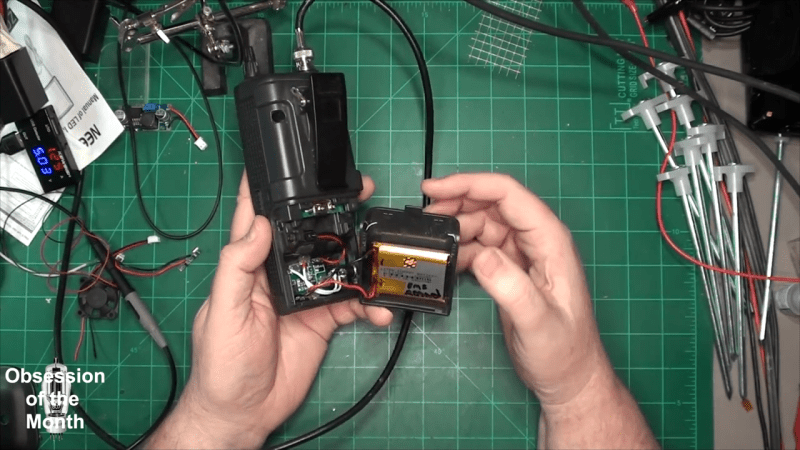If there’s anything people hate more than being locked into a printer manufacturer’s replacement cartridges, it’s proprietary batteries. Cordless power tools are the obvious example in this space, but there are other devices that insist on crappy battery packs that are expensive to replace when they eventually die.
One such device is the Uniden Bearcat BC296D portable scanner that [Robert Guildig] found for a song at a thrift store, which he recently gave a custom LiPo battery upgrade. It came equipped with a nickel-cadmium battery pack, which even under the best of circumstances has a very limited battery life. Using regular AA batteries wasn’t an option, but luckily the space vacated by the OEM battery pack left a lot of room for mods. Those include a small module with BMS functions and a DC-DC converter, a 2,400 mAh 4.2 V LiPo pillow pack, and a new barrel connector for charging. With the BMS set for six volts and connected right to the old battery pack socket, the scanner can now run for seven hours on a one-hour charge. As a bonus, the LiPo pack should last a few times longer than the NiCd packs, and be pretty cheap to replace when it finally goes too. There’s a video after the hop with all the details.
If you’re looking at a similar battery replacement project, you might want to check out [Arya]’s guide to everything you need to know about lithium-ion circuitry.

















NiMH is a good sub for NiCd in most applications. But LiPO is even better!
Nicad cells actually have longer cycle life time than lithium cells – you can get more recharge cycles out of a nickel cadmium cell than from a lithium cell.
https://batteryuniversity.com/article/bu-208-cycling-performance
Lithium cells are lighter for the same capacity than nickel cadmium, and they don’t contain cadmium (a heavy metal that can cause poisoning if it gets into the ground water.)
Any way you slice it, though, nickel cadmium cells are far more rugged and dependable than lithium cells.
Except for the bit where half the time you find they refuse to actually do their job because of memory effect, voltage depression / internal resistance, etc. And even when they work they have less capacity for the size, meaning that to last the same length of time they’d need to last an even greater number of cycles. And while you can make lithium last longer by putting it on charge before it’s empty and by stopping the charge before it’s full, nicad actually suffers if you do. The linked test is 100% depth of discharge, which favors that difference.
Have to agree with spaceminions, NiCd are mostly rubbish compared to Lithium chemistries. In practice you will get massively less life out of them, they don’t have the power density to be nearly as useful and are almost impossible to actually discharge deep enough to get that large cycle life out of them anyway. So you are cycling them way more often for lack of capacity, and as you can’t run them flat enough first killing them in almost no cycles…
On very rare occasions they might be the best choice, but on the whole Lead acid or on of the Lithium chemistries (LiFePO4 being a standout for durability, your normal LiPo being usually the standout for energy density) are better.
Not a fan of NiCds, They seem to work fine as long as you keep using them and charging them, but letting them sit, either unused or on a charger (no matter how carefully designed) will cause one or more of the cells to short out and kill the pack. It’s not memory effect, it’s whisker growth, because if the short is not too severe, a high current through the cell will blow the whisker and allow the cell to charge again. But, pretty soon, the cell will short out again.
NiMH don’t behave as badly, but they, too want use to keep them in prime condition. Lithiums don’t seem to require the constant use to remain usable.
I’m with the other anti-NiCd/NiMH folks here; but on the plus side, due to NiMH failure, I got a free Roomba vacuum in otherwise good shape :D
I ordered a chinesium knockoff battery just to get it working, but I plan to hack some Lipos into the original battery later, along with a charger conversion.
‘any way you slice it’ except for the part where the damn things need recharging whenever you wnt to use a device that uses them as a powersource.
Nice application. We all have 18650 or old cell phone or device Lithium batteries lying around. Great way to put them to use. Looked at Aliexpress for the charge/boost modules and found a handful. Please list which module you are using… to find it on the web.